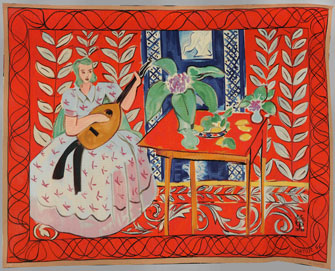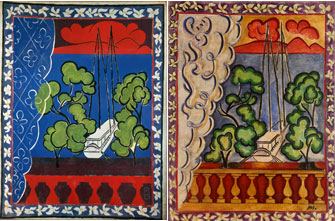The Ins and Outs of
Weaving an Artist’s Works

“Polynésie, le Ciel” (1946), by Henri Matisse. Centre Pompidou, MNAMCCI, Dist. RMN-Grand Palais/Jacqueline Hyde. © Succession H. Matisse
Last week, we reported on the exhibition celebrating the 350th anniversary of the Manufacture Nationale de la Tapisserie in Beauvais and a show of royal tapestries at the Galerie des Gobelins in Paris. Now another exhibition featuring tapestries has opened at the Musée d’Art Moderne in Troyes: “Tisser Matisse,” the first to focus on the artist’s textile works.
One of the pieces in the Beauvais exhibition was “Polynésie, La Mer” (1959), after Matisse. In Troyes, both pieces of the diptych, which also includes “Polynésie, Le Ciel,” are on display, giving visitors a chance to compare Matisse’s cartoons (made by the artist with cutouts and paint) for the Polynesia diptych with the finished product, an interesting lesson in how colors and patterns are transposed from the artist’s original conception into the woven form, not always perfectly successfully and not always fully satisfactorily to the perfectionist Matisse, who was disappointed by the way his white cutouts were translated into gradations of white on the tapestries.
A weaver who is transposing a work of art is considered an artist in his or her own right and must interpret the cartoon using the colors of thread available and adapting it to the “pixelation” effect imposed by the warp and weft of the loom, with varying results.
A blatant example of weavers’ different interpretations of a cartoon is offered by two woven versions of Matisse’s “La Femme au Luth” (1949). The first, which was approved by

The first woven version of “La Femme au Luth” (1949), by Henri Matisse. Manufacture des Gobelins. Photo: Isabelle Bideau © Succession H. Matisse
Matisse, is quite different from the second, which was made at a later date by a different weaver. The colors, especially in the leaves of the large plant sitting on a table next to the lady playing the lute, are very different in the second version, while the woman’s face seems to have gone all slack.
Another interesting textile piece is a silk wall hanging based on the paper-cutout decoration Matisse pasted on the wall of his living room on Boulevard Montparnasse in Paris. Like the “Polynesia” pieces mentioned above, also inspired by a stay in Tahiti, it is a jubilant celebration of the life of the sea, both under the water and in the sky, teeming with fish and birds and plants. Impressed by the flying fish and diving birds he saw there, he described Tahiti as a country where “fish fly and birds swim” and tried to convey the mixing of elements in these works.
Matisse’s textiles also come in the form of theatrical costumes and priests’ vestments for the chapel in Vence he so famously decorated. He also used paper cutouts to create his

Two versions of the same scene. Left: “Tahiti” or “Fenêtre à Tahiti II” (1936). Photo: Claude Gaspari © Succession H. Matisse. Right: “Papeete” or “Fenêtre à Tahiti I” (1935-36). Photo: François Fernandez © Succession H. Matisse
designs for the vestments, which a friend described as looking like colorful butterflies when pinned up on the wall of Matisse’s studio in Nice.
The exhibition, vibrant with Matissean colors, is supplemented with cartoons of unwoven pieces, cutouts from the famed book “Jazz” and other works, including drawings and even some silk scarves (made with the artist’s approval) bearing his designs.
The show offers a great excuse to visit the lovely provincial town of Troyes, just over an hour by train from Paris in Champagne country. Full of half-timbered houses, it has a stunning cathedral, located right next to the museum, which is housed in the former 16th-17th-century episcopal palace, with its large garden. The museum also has an extensive collection of art glass by Maurice Marinot, a local artist who was a friend of Pierre and Denise Lévy, the couple whose collection formed the basis for that of the museum.
Musée d’Art Moderne: 14, place Saint-Pierre, 10000 Troyes. Tel.: 03 25 76 26 80. Open Tuesday-Friday, 10am-1pm and 2pm-7pm; Saturday-Sunday, 11am-7pm. Admission: €5. www.musees-troyes.com
Click here to read all of this week’s new articles on the Paris Update home page.
Reader Reaction: Click here to respond to this article (your response may be published on this page and is subject to editing).
Support Paris Update by ordering books from Paris Update’s Amazon store at no extra cost. Click on your preferred Amazon location: U.K., France, U.S.
© 2014 Paris Update
Favorite